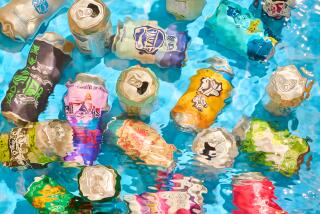Three myths about skunky beer
There is a whole spectrum of “off flavors” that can plague beer, but there is one flaw that is so common many people feel that it’s an intentional flavor in certain brands -- especially a particular brand of Mexican lager. Beer with the distinct aroma of skunk seems inescapable, but the realities of the scourge are simple and (mostly) preventable. There are lots of myths and misinformation surrounding skunky beer, but let’s set the record straight.
Myth No. 1: “Beer gets that skunky flavor because ... ”
We’ve heard just about every explanation for why you may get a whiff of skunk when enjoying a cold brew, from the ever-popular theory that letting cold beer warm to room temperature will cause it to skunk (not true, and not particularly harmful to beer), to the idea that brewers add the flavor during the brewing process (we’ll get to this one). The truth is simple: the musky aroma has one cause: a chemical reaction that occurs when ultraviolet light interacts with the bitter hop compounds in a brew.
A skunky beer is called “lightstruck” by chemists and beer nerds, and this is why you’ll often find odoriferous brews in clear or green bottles. Brown bottles block much more light and are a far superior vessel for beer, and cans (and kegs) are even better at protecting against UV exposure.
Myth No. 2: “It takes a lot of exposure to light to skunk a beer.”
The exact details of the chemical reaction are pretty complex, but the basic idea is the UV light hits the hop compounds in the beer, which results in the creation of the offending compound -- 3-methylbut-2-ene-1-thiol (3-MBT for those who don’t recall their organic chemistry lessons). It doesn’t take all that much radiation to cause the reaction. Humans are remarkably good at detecting 3-MBT -- just four parts-per-trillion of the compound can be noticeable, making it one of the most powerful flavors in beer.
The reaction happens fast enough that a glass of beer can become noticeably lightstruck in seconds when exposed to direct sun. Watch out where you set your brewski down at the next barbecue.
Myth No. 3: “Some beer is supposed to taste skunky.”
Lightstruck beer is such a common occurrence that many folks just assume that Corona or Heineken is supposed to taste like that. The truth is that skunky beer is flawed, and no brewer wants their beer to taste like the back-end of a skunk. Unfortunately, the brewers don’t always have final say in how their beers are marketed and sold, and there are many brands that feel their packaging is more important than the flavor of their beer.
You can now find cans of some of the most commonly affected beers like Heineken and Corona (or Corona Familiar, which is the same beer as Corona Extra but packed in large, brown bottles), and these packages are a better representation of how the beer should taste. Miller Brewing still uses clear bottles for some of their brands (High Life), and they skirt the lightstruck issue by using specially formulated hop extracts that do not react with UV light to create 3-MBT.
If you’re drinking a beer where the predominant flavor is that of a skunk’s musky juices, perhaps it’s time to look to some different brews.
ALSO:
Oreo snack hacks by Michael Voltaggio and moreGood Eggs delivers artisan products in L.A. -- for free
Look, ma, no booze! Fancy non-alcoholic drink pairings
More to Read
Eat your way across L.A.
Get our weekly Tasting Notes newsletter for reviews, news and more.
You may occasionally receive promotional content from the Los Angeles Times.








